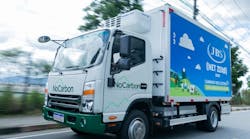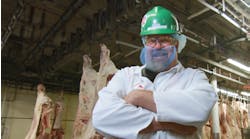We have three other stories on JBS as our Processor of the Year; see notes at the end of this story.
Perhaps more than other animal protein companies, both JBS S.A. and JBS USA appear to be committed to animal protein for the future. That makes them acutely aware of and focused on agribusiness’ significant roles in addressing global warming and other environmental problems. As a result, JBS established a global aspiration in 2021 to achieve net-zero greenhouse gas (GHG) emissions in all its operations by 2040.
Other food & beverage companies have made sustainability pledges and goals, but JBS is engaging all its operating units across the globe and its entire supply chain – farmers/ranchers, suppliers, even retail customers. The endeavor even ties environmental performance to executive compensation. It’s an ambitious statement.
If that sounds audacious, “We are confident that we will make it,” says Jason Weller, JBS S.A.’s global chief sustainability officer. “We don’t have a choice. We have a climate crisis. JBS is serious about the impacts of a changing climate on our global food system, and we believe that agriculture must be part of the solution.”
“JBS is in a really key position [through its global footprint] where we can first take care of our business within JBS and reduce our environmental footprint broadly but also serve as a catalyst, an agent of change within the food system, where we can signal to our farmer suppliers and also partners downstream of the need to take action.”
Weller’s been on the job just a year, coming immediately from a similar position at Land O’Lakes and before that serving as chief of USDA’s Natural Resources Conservation Service. His JBS position was created to add focused global leadership and coordination between global priorities, like the net zero aim, and the efforts at JBS locations at the local level in the 20 countries where JBS operates.
“Sustainability” is a deceptively complex word. At its fullest, it requires not just a reduction in the negatives – such as greenhouse gases, water pollution, wasted energy, etc. – but doing so while sustaining the business: the processing plants with their thousands of jobs, the economic benefits to the local communities (many of them rural) and the company’s ability to feed the world.
So Weller talks a lot about eliminating waste, in all its forms. Wasting less food and inputs, less energy, less water. Less waste automatically translates into more food for a growing world. At the same time, it means lower costs to JBS and improvements in the environment.
JBS S.A. lists five initial steps to reach net zero:
1.Invest more than $1 billion in upgrading facilities and equipment by 2030.
2.Invest $100 million in research and development projects by 2030.
3.Reduce emissions intensity by 30% by 2030.
4.Use 100% renewable electricity by 2040.
5.Tie environmental performance to executive compensation to ensure accountability.
Weller says JBS is well on its way to fulfilling these ambitions. These global goals and progress include:
- Achieve net-zero greenhouse gas (GHG) emissions by 2040
- Reduce Scope 1 & 2 GHG emission intensity by 30% by 2030 vs. 2019 baseline
- Reach 60% renewable electricity by 2030 and 100% renewable electricity by 2040 (45% of the electricity used in its operations was renewable in 2022).
The corporate focus on net zero began in 2021. Starting that August, employees were asked to come forward with investment proposals for their facilities. Since then, more than 180 have been approved and budgeted for $123 million and counting. Projects range in type, scope and scale, but all are assessed based on their contribution to actual GHG reduction.
“Every project is judged off the same score sheet,” says Mark Ritsema, who is head of environmental sustainability at JBS USA, working hand in hand with Weller. “We're looking at the dollars that we're spending per ton of greenhouse gas removed and what the payback to the business is,” which is usually the product of reduced cost or improved operational efficiency over time.
The Souderton, Pa., plant’s wastewater treatment system processes more than 1.5 million gallons per day before it is returned to nearby Skipper Creek. The bacterial treatment of the effluent requires a steady flow of oxygen, which had been supplied with a series of fans. But they can be costly to run and can’t be adjusted with rising and falling oxygen levels. So the six existing fan blowers were replaced with a turbo blower that can modulate itself using oxygen sensors in the wastewater basins, saving energy when oxygen levels are too high for the bacteria and increasing the air supply when oxygen levels drop. The turbo blower provides a 30% efficiency gain for the aeration system. Electricity use at the facility will be reduced by 900,000 kilowatt hours per year, reducing greenhouse gases by 285 metric tons.
A project to generate heat and power from captured biogas will yield a 15% GHG reduction at the JBS beef plant in Plainwell, Mich., and will create further offsets by reducing the amount of natural gas and electricity the facility would otherwise buy.
At the Pilgrim’s Pride plant in Enterprise, Ala., an anaerobic lagoon, which treats wastewater from the plant, is being improved with a $6 million investment that will cut GHG emissions by 40%. The six-acre pond is being completely overhauled, covered with a huge plastic sheet to create the anaerobic conditions the bacteria need and to capture the methane byproduct. The methane will later be captured to offset GHGs by powering water heaters or electrical generators at the plant.
While a global JBS initiative, it’s at the facility level where change happens. “The fact is, our team members are actually the ones making the change,” Ritsema says.
JBS USA also has contributed more than $1.2 million to climate change research projects in partnership with non-governmental organizations and universities.
- $230,000 went to Colorado State University’s AgNext program to help cattle producers implement sustainable grazing practices, including methane-measuring technologies and GPS collars on cattle.
- $700,000 for the University of Nebraska-Lincoln Foundation to support a new Feedlot Innovation Center.
- $150,000 for the Soil and Water Outcomes Fund to drive carbon sequestration, improve water quality and create economic opportunities for growers to profit from conservation practices, such as no-till and cover crops.
- $100,000 for the Foundation for Food and Ag Research-Greener Cattle Initiative. JBS is among 10 companies funding almost $5 million over the next five years to support research and development of practices and technologies to reduce enteric methane emissions from cattle.
- $33,000 for the University of Minnesota to utilize the Food System Supply-chain Sustainability (FoodS³) transportation model to map the animal supply sheds and their associated feed sheds within the U.S., as well as the greenhouse gas impacts associated with these supply chains.
SEE ALSO:
2023 Processor of the Year: JBS USA



